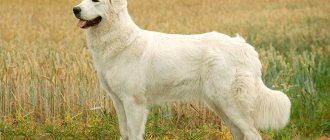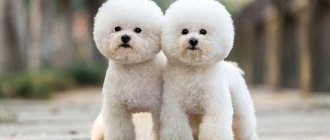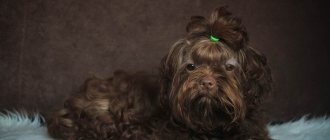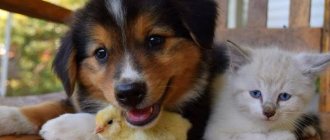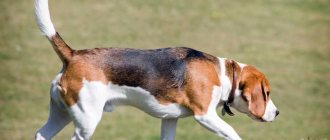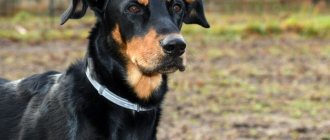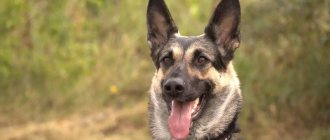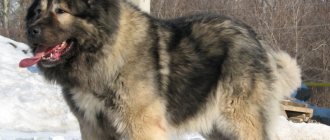Polish Podgalian Shepherd Dogs are tall, heavy dogs with fluffy white fur and dark almond-shaped eyes. Spectacular, powerful animals have long been used to protect high-mountain herds of cattle, and are now used in various fields, including police and guard service.
Let's find out what Polish Podgalian Shepherds are and what the specifics of keeping the breed are.
Breed characteristics
| Short description | |
| Origin: | Poland |
| Conditions of detention: | Yard, aviary |
| Purpose: | Cattle dog, guard, companion |
| Color: | White, cream |
| Wool length: | Average |
| Adult dog size: | The height of the female is 60-65 cm, the male is 65-70 cm; male weight – 55-70 kg, female – 45-55 kg |
| Average life expectancy: | 12-16 years old |
| Walk: | Twice active walking is required |
| Physical activity needs: | High physical activity needs (workouts, games, jogging) |
| Fédération Cynologique Internationale (FIC) classification: | Group 1: herding and cattle dogs except Swiss cattle dogs; section 1: shepherd dogs |
| Puppy price: | Without pedigree – 30-35 thousand rubles; pet class – up to 50 thousand rubles; breed class – 70-80 thousand rubles; show class - up to 120 thousand rubles. |
Origin of the Polish Podgalian Shepherd Dog
The history of this breed began not in Poland or even in Europe, but in parts of the globe very remote from them. Presumably, the ancestors of these dogs came to their new habitat from the mountainous regions of Tibet during the great migration of peoples. Huge white dogs of the Tibetan Mastiff breed accompanied their owners during this long journey, helping them guard livestock and property.
Having settled in Eastern Europe, the dogs continued to perform their functions as guards and shepherds, but their appearance underwent changes under the influence of the new climate and crossing with local dogs and wolves. This is how a new variety appeared, which began to be called the “Tatran Sheepdog” in honor of the mountainous Tatra region, located in southern Poland. The first mentions of Polish Podgalian Shepherd Dogs date back to the 7th century, and breeding of this breed began only in the middle of the 20th century.
We suggest you read: How to treat urolithiasis in cats
Beginning in the 50s of the last century, breeders began to seriously cultivate Tatra Shepherd Dogs and established exterior standards that they still follow when breeding. The place of residence of Polish Shepherds is now not limited to their homeland: farmers in North America have fallen in love with these beautiful and hard-working dogs.
Proper care of the Polish Podgalian Shepherd requires the owner's free time and attention. Beginning dog breeders mistakenly believe that an adult dog is supposed to be accustomed to the procedures.
Polish Podgalian Shepherd puppies, accustomed to hygiene procedures from an early age, get used to the daily routine. As adults, trained dogs behave calmly while combing and cleaning their ears.
Train your pet to wash or dry its paws after a walk. As the dog grows older, it will not allow itself to enter the room with dirty paws; it will remain patiently waiting in the hallway, periodically reminding itself.
How to care for the Polish Podgalian Shepherd and its snow-white coat is a question that constantly interests novice breeders. It is enough to comb the soft fur of the animal thoroughly at least once a week. During the molting period, the frequency of scratching is increased, carefully combing out dead hairs.
Keeping an animal in an apartment is possible, but not advisable. The ideal place for a shepherd is a country house and a spacious enclosure. If your pet lives in a city apartment, try to arrange so that the dog does not get bored. Provide long walks and runs. Whenever possible, try to take them outdoors to a forest or park.
The Polish Podgalian Shepherd Dog breed is a working dog. Don't stop your dog from trying to help you. Irrepressible energy does not allow the animal to sit still. The owner has the right to try to direct the performance in the right direction, for example, by offering to actively play with the children.
Representatives of the breed treat children affectionately and with some condescension. They carefully look after them and allow the children small liberties. The Shepherd is extremely devoted to the family. Other people forever remain strangers to dogs, whom the dog always closely monitors.
History of the origin of the species
These dogs are one of the most ancient, their origin dates back to the 3rd-5th century AD . They probably appeared in eastern Europe (Podhale, which is where the name comes from) with Roman conquerors or nomads from Asia.
The second name for shepherd dogs is Tatra. It also has to do with origin. Dogs may have originated in the High Tatras Mountains. The breed is closely related to the Tibetan mastiff and the Eastern European wolf.
Interestingly, no one improved dogs until the 20th century. Selection work began relatively recently, after the Second World War. The standard for shepherd dogs was issued in 1973.
Health and illness
The Polish Shepherd has good immunity. This is due to the fact that the appearance of the breed was natural. The breed appeared in the mountains, in harsh climatic conditions. The owners did not monitor the comfort of their pets, and therefore they are in good health.
But despite this, diseases can also occur in them.
The most common pathologies include:
- hip dysplasia, which occurs in large dogs;
- problems with the digestive system.
It may appear as a result of the introduction of a new brand of food or due to improper feeding.
Lifespan
The breed is long-lived. They live on average 10-14 years , but can delight their owners for 16-17 years.
Distinctive features
The dogs are classified as giant breeds because they can reach up to 70 cm and weigh up to 75 kg. Their main advantage is their white fluffy fur. Externally, the Tatr resembles its ancestor – the Tibetan Mastiff.
- The head is medium in size with a convex skull and a shallow groove. Stop smoothly.
- The muzzle is straight, tapering slightly towards the nose. Approximately equal in length to the skull. bite .
- The eyes are medium-sized, almond-shaped, slightly slanted, color dark brown.
- The ears are set above the eye line, hang down on soft cartilage and fit tightly to the head. Medium in size, rounded triangle shape.
- The nose is large, black;
- The body is rectangular, strong and heavy. The topline is straight with curved withers and a convex croup. The loin is short and wide. The neck is of medium length. The chest is voluminous.
- The tail is a continuation of the croup, hangs down and curls at the end.
- The limbs are long, straight and parallel with rounded paws.
- The coat is medium length, fluffy and soft with a dense undercoat.
- Color – white.
Socialization and training
Like any native dog, formed naturally, the Polish Podgalian Sheepdog is perfectly adapted to life in the open air. In the natural environment it is able to find food. The dog's size and strength allow it to win in single combat with a wolf; its thick coat helps it not to freeze on cold, long winter nights. A dog is able to survive without human intervention.
It is better to keep the Podgalyan Shepherd Dog in the yard, where it can exercise its guarding abilities. It is acceptable to keep it in an apartment, but you will need to walk often and for a long time, it is better outside the city, where you can let the dog run around without a leash. Then the dog receives a balanced load on the body and joints. Most shepherd dogs, including Tatra dogs, live in a dual mode: in winter - in an apartment with their owners, in summer - in the country, where they go with pleasure. Shepherd dogs do not have “digging mania”; the vegetable garden and flower beds will not be damaged.
The snow-white Polish Shepherd gets along well with family members and is an excellent nanny. The Podgalyan Shepherd Dog has retained its pack instinct, therefore, the more people there are in the family, the better for the dog. It is possible to safely leave the child with the dog. The dog will not touch the baby and will protect it from the attacks of strangers.
People are known to choose a dog to put on a chain. A chain does not decorate any dog, nor the owner. Chaining a Tatra Shepherd is tantamount to cruelty and abuse of the animal. The Podgalian will become sad, the dog’s character will deteriorate, and serious health problems will appear.
The Podgalyan Shepherd Dog does not deserve rude treatment and does not tolerate this kind of behavior. The dog does not tolerate coercion; if you behave incorrectly with the pet, it will show remarkable stubbornness.
In order for training and training to be easy and relaxed, the owner will have to establish a trusting relationship with the pet. There is no point in teaching your pet security skills. In dogs, these skills are innate and strongly expressed. They intuitively know how to defend and secure the territory.
The training of the Polish Podgalian Shepherd Dog is carried out gradually. Sufficient independence in the pet’s character should be taken into account. It is advisable to make a special door for the dog, leaving the opportunity to go for a walk or relieve its natural needs on its own.
Animals are suspicious of strangers and strangers. Do not express aggression or dissatisfaction. You should not think that a shepherd will ignore strangers. Even when playing or minding its own business, the dog will begin to become restless and constantly watch strangers. Dogs use their teeth only in cases of extreme necessity and will not warn about this by barking.
Photo of an adult dog
Nutrition
Due to its large size and high activity, the Polish Shepherd must eat properly. Dry types of food and natural products prepared at home are equally suitable as food. It is important to know that you should not mix both types of food, as this can lead to digestive problems for the dog. Natural nutrition should consist of lean meat, cottage cheese, chicken and quail eggs, fresh vegetables and fruits, and boiled cereals.
As a treat, you can sometimes give small amounts of yogurt and cheese. When choosing purchased food, you should pay attention to the manufacturer and the intended use for certain breeds of dogs.
Photos of puppies
What is it for?
The Tatra Shepherd Dog has guarding qualities from birth, being the most vigilant guardian of the owner’s property and home. The appearance of the representatives of the breed inspires not only respect due to their large size, but also fear. The Poles only occasionally used the animal as a herder . The main activity of the dog was to guard property and also to transport cargo to its destination. Podgalyanoks are also involved in guard duty, where they valiantly guard places of detention, keeping an eye on the prisoners.
The Poles call this breed nothing more than the Tatra Mountain Dog. She is gladly accepted into the ranks of special forces rescuers. In emergency situations, large powerful creatures help save people. Its kind disposition and boundless adoration for children allows this dog to be used in a canistherapy program to work with children with disabilities.
Features of character and behavior
At first glance, the Polish Podgalianskaya may seem stern and intimidating due to its size and menacing grin. In fact, dogs are balanced and calm, rarely the first to rush into battle. They are very responsible and know the value of their actions.
From birth, Tatras have a protective instinct. This is due to the centuries-old fulfillment of a single duty - to graze and protect livestock. Animals are always vigilant, courageous, they have a well-developed reaction, and increased attention to detail.
These qualities helped the breed remain in demand after the reduction in livestock production. The dogs were taken into service in police and rescue services.
Tatr does an excellent job of protecting property. At the same time, the dog is not aggressive at all. He loves children and needs constant contact with his owner. For a long time, Podgalians worked side by side with other dogs, so they tolerate the company of their relatives well.
Shepherd dogs have learned to make decisions on their own. If the owner does not want such self-will, then he will have to try hard to break the stubborn character of the animal. A dog will not listen to a person if he does not see him as a leader.
Advantages
Owners of podgalyankas claim that a better breed cannot be found. They highlight the following advantages in dogs:
- Not annoying;
- Self-sufficiency;
- Equilibrium;
- Love for children;
- Developed protective instinct;
- Good physical shape;
- High level of intelligence and quick learning ability;
- Not conflict.
Flaws
The Polish Podgalian breed is not the most difficult to train among the Molossians. Some dog handlers even claim that even a child can handle training Tartre. But in fact, animals are quite stubborn and arrogant. Other disadvantages of Polish Podgalianskie:
- Choice of one owner (Tatr gets along well with household members, but trusts 100% only one owner);
- Grudge;
- Laziness.
Security qualities
The herding Polish Shepherd has very developed guarding qualities. This dog is on duty around the clock. She sleeps lightly; the slightest rustle makes the representative of the breed wary.
Suspicious of strangers. Without a command, he will touch in one case: a stranger poses a danger to family members or to the dog himself.
If the owners of the house and someone comes to visit, the dog will watch. The guest appeared in the absence of household members, then an extremely unfriendly reception awaits him.
IMPORTANT! The ideal guard. Representatives of the breed feel comfortable in a large enclosure on the territory of a private house.
Care and maintenance
It is not worth considering such a giant breed as an apartment option. Firstly , the animal will suffer from heat and cramped conditions. Secondly , keeping a pet will bring discomfort to owners and household members: a lot of hair and a constant need for physical activity.
The ideal option for the Polish Podgaliansky is a large country house with a spacious garden where the dog can walk independently.
You cannot put your pet on a chain; this will negatively affect his psyche. Aviary keeping is possible if the cage is spacious enough, has a roof and heating for the winter.
Nutrition
It may seem that such a large dog needs huge portions filled with choice meat. In fact, the Polish Shepherd eats little and does not require special conditions - nutritious, wholesome food is all it needs.
- At 1.5-2 months, the puppy begins to be fed and weaned from the mother's breast. Then only natural food based on milk porridge and cottage cheese is allowed.
- From 3 months it is allowed to introduce dry food into the diet - a smooth transition to eating ready-made foods.
For the Polish Podgalianskaya, you need food with large granules, only super-premium class with a meat content of 40%. Depending on the age or current condition of the pet, a specific line is chosen: puppies, pregnant, elderly, lactating, allergy sufferers, post-operative animals.
Natural food should also contain at least 40-50% protein (chicken, beef, lamb, salmon, eggs, cottage cheese, kefir). The remaining share can be occupied by vegetables and cereals, for example, buckwheat and oatmeal. For adult animals, 1-1.3 kg of food at a time should be enough. Puppies are given food 3-5 times a day , 40-50 grams .
It is strictly forbidden to give chicken or fish bones. If you are choosing a natural delicacy that is good for your teeth, it is better to purchase raw beef shin.
We recommend that you read a detailed article on the topic: “How and what to feed a dog: types and characteristics of nutrition.”
Health
The Polish Podgalian Shepherd appeared in the mountains, where the breed developed without human intervention. Although the gene pool of the breed is quite poor, the dogs are in good health. Given their gigantic size, shepherd dogs live 12-16 years , provided they receive quality veterinary care, regular vaccinations, and proper nutrition.
Vaccinations
Despite the fact that the dog is large and healthy, it, like all animals, needs to be vaccinated against dangerous viruses. Puppies are more vulnerable to infection than adults because they do not have their own immunity.
- Therefore, it is important to vaccinate your baby at 2-2.5 months against plague, parainfluenza, hepatitis, leptospirosis and enteritis.
- At 7 months of age, a rabies vaccination is required. The owner must follow the vaccination schedule. An entry is made in the pet’s veterinary passport with the date of vaccination and the drug administered.
- The vaccine does not last forever; after 1-1.5 years , all vaccinations are repeated without fail.
In addition to the mandatory vital vaccinations, you can give your pet additional ones - against lichen and subcutaneous ticks.
Before each procedure, the dog must be cleared of helminths so that the body does not receive additional stress. Also, on the day of vaccination, the pet’s temperature must be measured to make sure that the dog is healthy.
A small lump may form at the puncture site, which will resolve itself within 24 hours. Also, in the next 24 hours after vaccination, the pet may be lethargic and sleepy. If the symptom lasts more than 2 days , the dog must be taken to the clinic.
Important article on the topic: “Everything you need to know about dog vaccinations.”
Diseases
The most common breed diseases:
- Disturbances in the gastrointestinal tract (indigestion, diarrhea, gastric volvulus);
- Heart failure;
- Hip dysplasia (an incurable disease characterized by changes in the joint, manifested as severe pain and lameness).
Walk
Even if the dog lives in a spacious yard or in a large enclosure, where it is possible to move around, you need to walk with it at least 2 times a day for 1.5-2 hours . Large animals are mastiff-like and tend to be lazy. But a properly designed physical activity regimen will help avoid problems in old age.
You can run with your pet in the morning and visit dog parks in the evening. Another important component of a healthy walk is communication with fellow animals. Without this, the dog will grow up unsociable and embittered.
Grooming
The main rule in caring for shepherds is to start hygiene procedures as early as possible. If the puppy gets used to brushing and bathing from an early age, then when he grows up, there will be no problems.
It is recommended to comb long, profusely growing hair 3-4 times a week with a slicker brush. Animals shed all year round. bathe often - once every 3-6 months ; in the summer you can take the dog to a pond, and in the winter - roll around in the snow. After each walk, be sure to wash your animal's paws.
The ears and eyes are examined daily for the presence of inflammatory processes, which is indicated by abundant atypical discharge, redness, and swelling.
How to raise and train
A person who wants to raise this dog must learn to restrain his negative emotions and not offend his pupil. It is important to establish and maintain an even, friendly relationship with him from the very beginning.
Read Prague Rat - description and photo of a miniature dog
Rudeness and irritability are categorically unacceptable when communicating with an animal. At the same time, the dog must feel the indisputability of the owner’s will; firmness and strength of character combined with friendliness. Manifestations of weakness and rudeness are equally unacceptable.
Training begins at two months of age. At the first stage, the puppy must be accustomed to life outside the enclosure, yard, or home. He needs to be walked three to four times a day, even if he enjoys freedom within the area. The route needs to be varied; introduce the dog to new territories, other animals, people. It is necessary to accustom him to sharp sounds, unusual noises, and smells.
Classes should be conducted systematically and be interesting. Learning is built in development from simple to complex; You should not overtire the puppy; it is advisable to alternate the lesson phase with rest, giving him the opportunity to run or lie in the grass.
The duration of the lesson at the first stage is no more than 60 minutes.
Proper upbringing will provide your pet with a comfortable transition into adulthood, eliminating fearfulness and aggressiveness.
Mating
Large dogs are bred differently than small dogs. Firstly , it is almost impossible to carry out this procedure on your own. Secondly , the rarity of the breed makes it difficult to find a partner for a pet, so it is easier to match the animal through a club where a candidate with good external characteristics and good health will be selected.
The Tatras are unleashed at 2-2.5 years . For this, it is also better to contact specialists. Large, powerful girls can not only injure the male during mounting, but also harm the people around him.
Read a detailed article on the topic: “Everything you need to know about breeding dogs: appropriate age, what to do if it doesn’t work out, rules and tips.”
Feeding your pet
Before purchasing a puppy, think about the dog's nutrition. Choose the option that suits your pet's feeding needs. When choosing between dry food and natural products, evaluate your own capabilities. A small dog eats 6 times a day; an adult dog needs to be fed twice a day.
If you choose dry food, adhere to the following points:
- Buy premium food. Their composition is balanced and contains essential vitamins and minerals.
- When giving your pet a balanced dry diet, you should not add additional vitamins or mineral supplements to the food.
- When giving the daily dose, follow the instructions. Do not overfill the bowl with food.
- Remember, dry food makes you very thirsty; always place a bowl of clean water nearby.
You cannot feed your animal dry food and natural products at the same time. It is not recommended to give your dog food from the owner's table. Such complementary feeding will cause disturbances in the shepherd’s digestion.
Key points in training
It is important to maintain a balance when training a Tatra. The owner must be strict, demanding and serious, but always respect boundaries and not allow himself to hit, insult or shout at the dog. Shepherd dogs have developed intelligence, they understand the first time, but they need a leader - a leader. At the same time, they do not like to obey the weak, and react to aggression with aggression.
For training to proceed quickly and be effective, the owner and the pet must establish moral contact. You can teach a dog to trust only if you spend a lot of time with it.
Podgalians are guards from birth. They do not need to further develop their defense skill. But learning to control emotions and make decisions independently is a learning task.
Read a detailed article on the topic: “Everything you need to know about breeding dogs: appropriate age, what to do if it doesn’t work out, rules and tips.”
Training and education
The Podgalyansky Shepherd Dog requires discipline from childhood. If the owner spoils the puppy, it will not end well. Raising a male dog must be approached in a more strict manner than raising a female dog.
Golden rules for dog owners:
- consistency in actions and patience;
- everything happens gradually. They move from simple to complex;
- use inhibitory commands less;
- eliminate physical impact on the pet;
- if you want to raise your voice, then bite your tongue;
- remember that a dog is a reflection of its owner. She is not bad and stupid. The owner couldn't teach.
We work with the puppy every day. A few minutes with intervals between workouts. As the dog gets older, the load on it also increases.
Where to buy a puppy: nurseries
The breed is rare and expensive, so breeding it is expensive. But in large cities you can find official clubs selling Polish Podgalian Shepherd puppies:
- "Aneka Bos" Moscow;
- “From the Valley of Five Lakes” Voronezh.
The larger the dog, the more responsible the owner should be. A person is fully responsible for the behavior of his pet. Therefore, in order to avoid problems, it is necessary to train and educate the shepherd. And this requires a lot of time and financial resources.
3.7 / 5 ( 3 voices)
Average prices for puppies
Keeping a Podgalyan Shepherd puppy is a responsible and expensive undertaking. The value of this breed lies in its high protective qualities. The cost consists of several factors:
- pedigree;
- nursery;.
- development prospects;
- gender
Girls are more expensive. In the nursery, puppies are sold for 80-100,000 rubles. Purchasing a puppy from its historical homeland will cost 1000-1500 euros. You should not save money and buy a shepherd dog “from hand”; there is a danger of falling for the bait of scammers.
